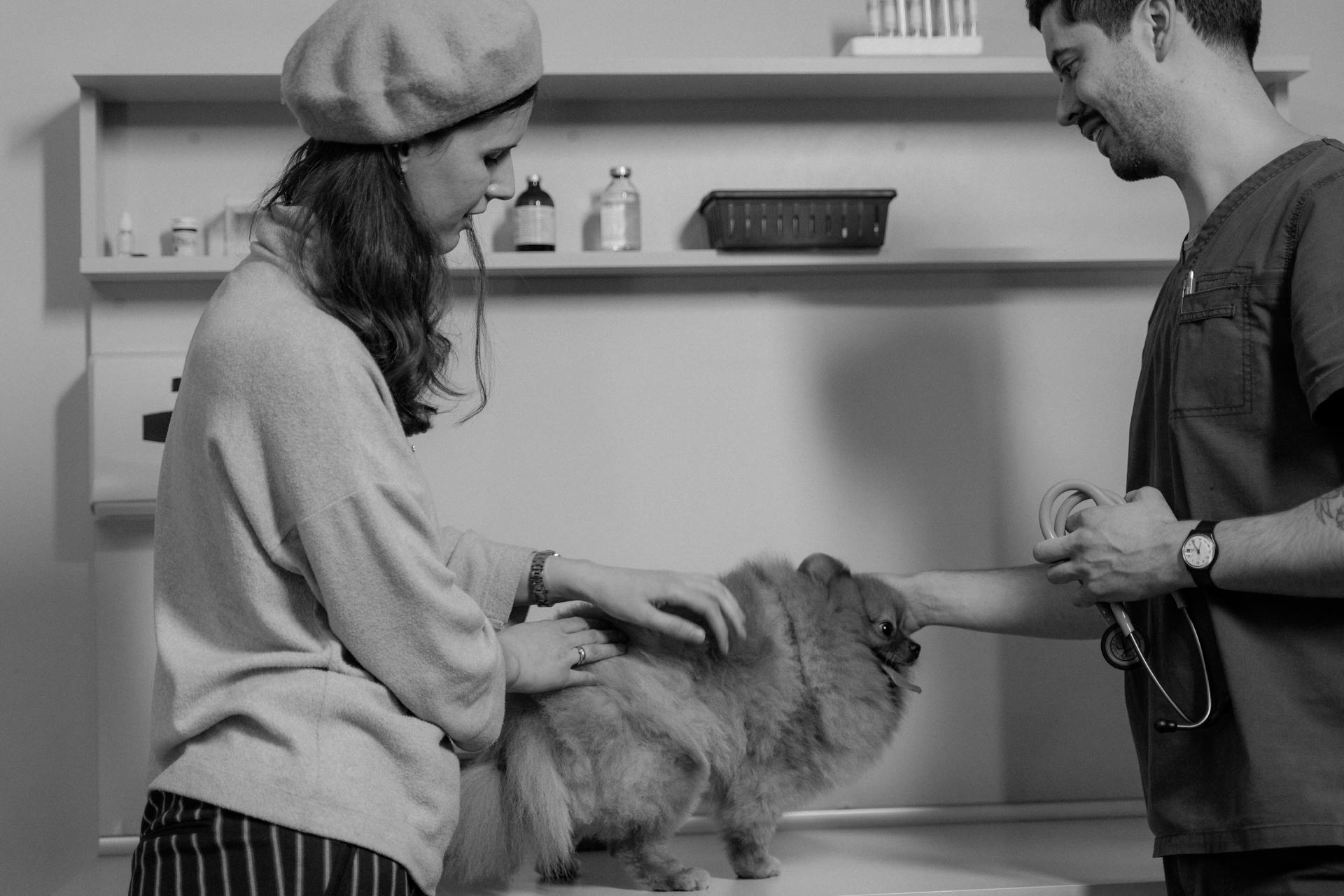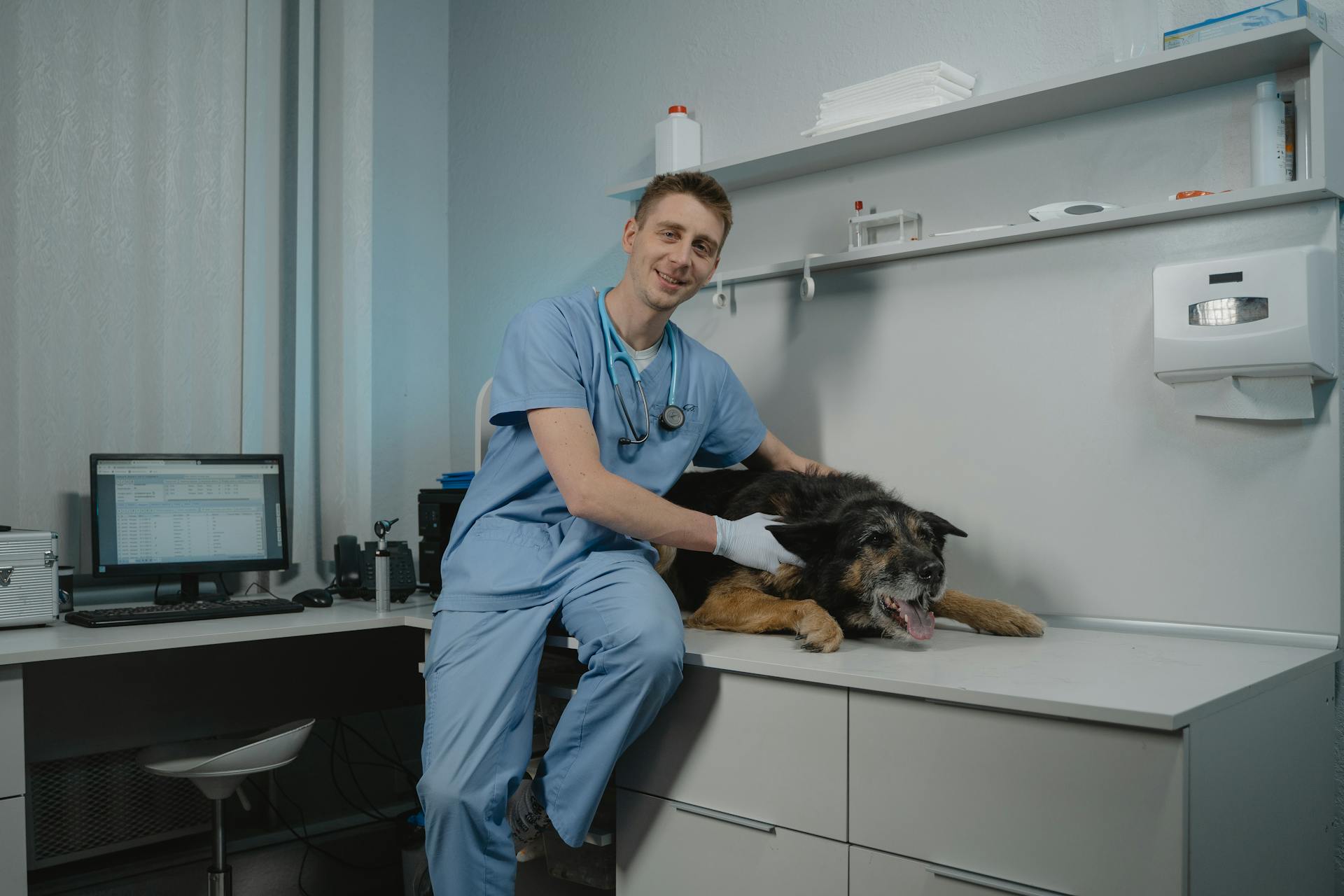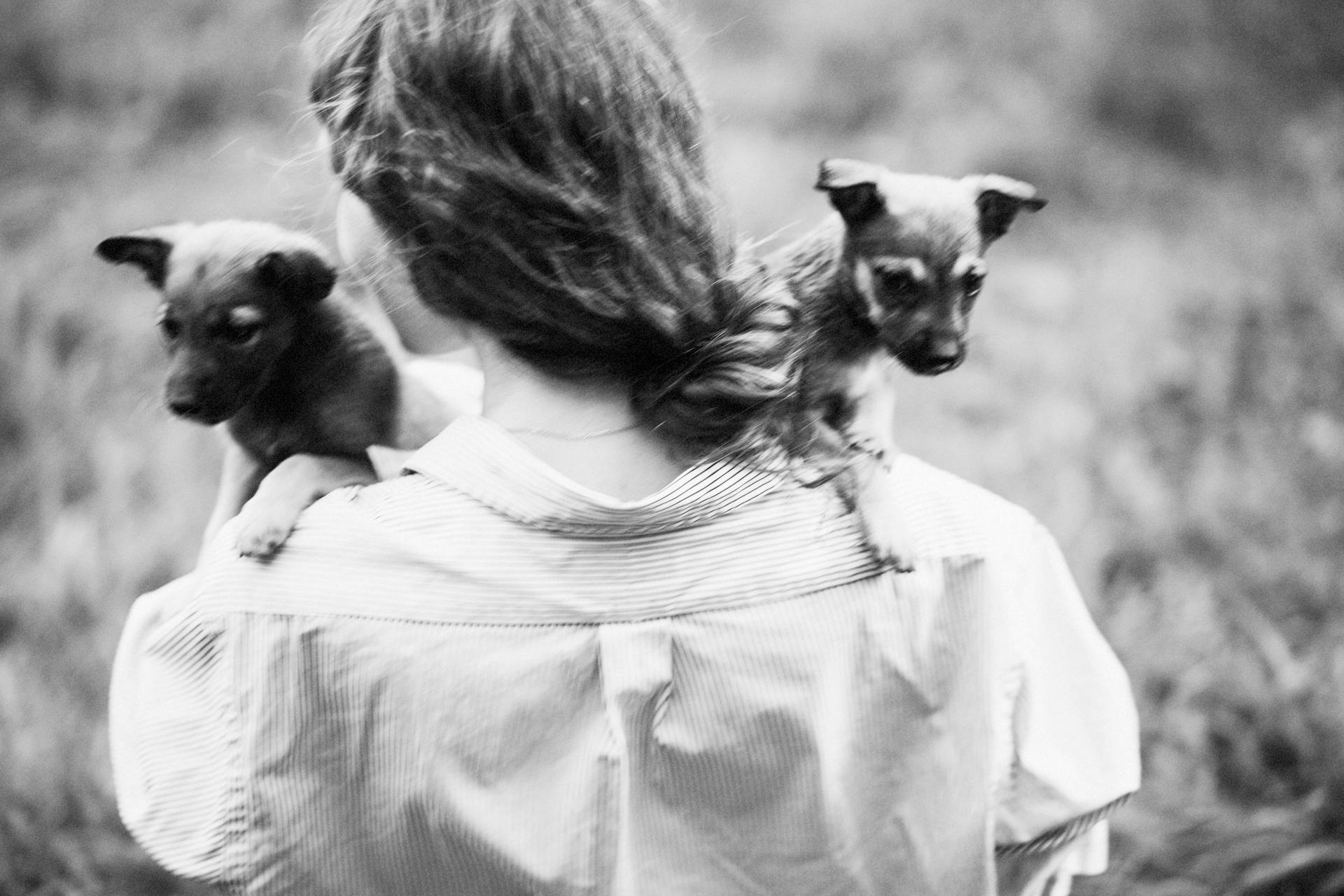
Brown discharge in female dogs can be a concerning issue for pet owners.
This discharge is often a sign of a healthy reproductive cycle, and it's usually accompanied by a strong, pungent odor.
However, in some cases, brown discharge can be a symptom of an underlying infection or medical issue.
A vaginal infection, such as bacterial vaginosis or yeast infection, can cause brown discharge in female dogs.
In these cases, the discharge may be accompanied by other symptoms, including itching, redness, and swelling of the vulva.
Brown discharge can also be a sign of a hormonal imbalance, which can be caused by a variety of factors, including age, breed, and medical conditions.
In some cases, brown discharge may be a normal occurrence during a female dog's heat cycle, and it's not a cause for concern.
However, if the discharge is accompanied by other symptoms, such as bleeding, vomiting, or lethargy, it's essential to seek veterinary attention.
Additional reading: Stages of Female Dog in Heat
Causes of Brown Discharge in Female Dogs
Brown discharge in female dogs can be a sign of several underlying issues. Pyometra, a uterine infection, can cause a foul-smelling brown discharge in older unspayed female dogs.
The heat cycle is another common cause of brown discharge in unspayed female dogs. This occurs when they go into heat approximately every six months and can lead to a bloody discharge from their vulva.
Urinary tract infections (UTIs) can also cause a brown discharge in dogs. If left untreated, UTIs can lead to more serious health issues.
Pregnancy loss can result in a brown, green, black, or yellow discharge with a foul odor. This is often accompanied by other symptoms such as vomiting and lethargy.
Vaginal trauma, which can occur during mating, can lead to a discharge. This can be a painful and distressing experience for the dog.
A retained placenta can also cause a brown discharge in dogs. If the placenta is not passed during whelping, it can lead to infection and discharge.
Diagnosing and Treating Brown Discharge

Diagnosing brown discharge in your dog requires a visit to the veterinarian, as it can be a symptom of a more serious underlying issue. Your vet will ask for a detailed medical history, including any medications, surgeries, or breeding activities, and will perform a physical examination to check for fever, signs of illness, and any abnormalities in the vulva and vagina.
To help your vet reach a diagnosis, be prepared to provide information about any discharge you've observed, including its color, consistency, and amount. They may also recommend diagnostic tests, such as a urinalysis, blood work, or ultrasound, to determine the cause of the discharge.
The veterinarian may perform a physical examination to check for fever and signs of illness as well as examine the vulva and vagina for trauma, signs of infection, or an abnormality. They may also take a sample of the discharge for culturing to identify the pathogen.
Treatment options will depend on the underlying cause of the discharge, but may include antibiotics, surgery, or vaginal douches, as well as anti-inflammatory drugs to ease swelling and discomfort. Your vet will work with you to determine the best course of treatment for your dog.
If this caught your attention, see: Treatment for Female Dog Incontinence
Diagnosis
Diagnosis is a crucial step in determining the cause of brown discharge in dogs. Your veterinarian will need a detailed health history, including any medications, surgeries, or breeding activities, as well as information about your dog's spay status and any sexual involvement with other dogs.
A physical examination will be performed to check for fever, signs of illness, and to examine the vulva and vagina for trauma, infection, or abnormalities. This is especially important if your dog is intact (not spayed) and experiencing heightened vaginal discharge after estrus.
Blood tests may be performed to gauge the severity of an infection and to rule out septicemia, a life-threatening blood poisoning. Your veterinarian may also use ultrasound to provide medical images of your dog's pelvic region, which can help identify masses or other abnormalities.
In some cases, a sample of the discharge may be taken for culturing to identify the pathogen. This is especially true if the urinary tract and vagina are suspected of crossing-contaminating infections.
If this caught your attention, see: American Bully Ear Infection

Here are some diagnostic tests your veterinarian may recommend:
- Bloodwork—A complete blood count (CBC) and biochemistry profile to assess your dog's overall health and detect infection.
- Urinalysis and urine culture—To detect a UTI and identify the cause.
- Vaginal cytology and culture—To determine if the cells in the area are abnormal and if infection is present.
- X-rays—To evaluate the internal organs and detect abnormalities that may cause the vaginal discharge.
- Ultrasound—A noninvasive imaging technique to assess your dog's uterus and surrounding structures.
Your veterinarian may also recommend a vaginoscopy, a procedure that involves inserting a flexible camera into the vulva and vagina to visually examine the inner walls of the vagina and collect a sample of cells for microscopic examination.
Treatment
Treatment of brown discharge in dogs depends on the underlying cause, but your veterinarian may recommend a range of options.
For infections, antibiotics are often prescribed to clear up the infection, and in some cases, surgery may be necessary to remove the infected uterus or repair any damage.
Your vet may also advise intravenous fluids and pain relief to help prepare your dog for surgery.
If your dog has a urinary tract infection or vaginal infection, oral antibiotics may be necessary.
Surgery may also be necessary to remove a retained placenta or fetus, or to repair a defect or trauma.
In some cases, your vet may prescribe a dilute chlorhexidine or povidone-iodine solution for vaginal douching to help clear up vaginitis.
Discover more: How Long Does It Take to Spay a Female Dog

Treatment for puppy vaginitis usually consists of daily cleaning of the vulva until the puppy outgrows the condition, which can be done with an unscented baby wipe or a gentle antibacterial soap.
For bacterial infections, antibiotics may be necessary, and for yeast infections, antifungal drugs may be prescribed.
In some cases, surgery may be necessary to correct structural problems that do not correct themselves as the dog matures.
Here are some common treatment options for brown discharge in dogs:
- Surgery
- Antibiotics
- Vaginal douches
- Antifungal drugs
- Anti-inflammatory drugs
Your vet may also recommend keeping the area clean and dry to help keep your pet more comfortable during treatment.
Symptoms and Recovery
Symptoms of brown discharge in female dogs can be subtle, but there are some common signs to look out for. A dog with a vaginal or vulvar condition may exhibit vulvar swelling or redness, hind end scooting, frequent urination, spotting blood, or licking the perineal region.
In some cases, the discharge may be accompanied by vulvar swelling or redness, which can be a sign of an underlying issue. If your dog is experiencing any of these symptoms, it's essential to take her to the vet for a proper diagnosis.
The recovery of your dog will depend on the condition causing the discharge. Most infections are easily treated with antibiotics and cleaning of the area, while more stubborn infections may need surgical cleaning and/or draining.
You might like: Swelling after Spaying Female Dog
Symptoms

If your dog is experiencing vaginal discharge, you may notice some specific symptoms. Spotting blood is one of the most noticeable signs.
Licking the perineal region is a common behavior in dogs with vaginal or vulvar conditions. They may do this to try and clean the affected area.
Vulvar swelling or redness can be a sign of a vaginal or vulvar condition. This can be painful for your dog and may cause her to avoid the area.
Hind end scooting can be a symptom of vaginal discharge in dogs. This is usually caused by anal irritation or discomfort.
Frequent urination can be another sign of a vaginal or vulvar condition. This is often due to the dog's discomfort or pain.
Take a look at this: Female Dog Vaginal
Recovery Following Treatment
Recovery following treatment for your furry friend can be a lengthy process, but with the right care, most dogs make a full recovery.
Most infections are easily treated with antibiotics and cleaning of the area. This usually does the trick, and your dog will be back to normal in no time.
A fresh viewpoint: Female Dog Spay Recovery

Cancers vary widely in their recovery rates, so it's essential to discuss treatment options and life expectancy with your veterinarian. This will give you a better understanding of what to expect.
Surgery to repair a defect or trauma is usually successful, but it's crucial to follow post-surgical care instructions to ensure a smooth recovery. Keeping your pet from chewing the area is also vital to avoid complications.
For puppies with vaginitis, keeping the area clean and dry will help keep your pet more comfortable during this time. This simple step can make a big difference in your puppy's recovery.
In some cases, puppies with structural problems may require surgery to correct the issue. However, the vast majority of puppies will outgrow the condition as they mature and have no further problems.
On a similar theme: Original Female Dog Names
Recovery and Management
Recovery from vaginal discharge in dogs can vary depending on the underlying cause. Most infections can be treated with antibiotics and cleaning of the area.

In some cases, surgical cleaning and/or draining may be necessary. This is especially true for stubborn infections. Cancers also vary in their recovery rates, so it's essential to discuss treatment options and life expectancy with your veterinarian.
If your dog is experiencing pyometra, prompt treatment can lead to a successful recovery after an ovariohysterectomy, also known as the removal of the uterus and ovaries. However, if left unspayed, the condition is likely to recur.
Juvenile vaginitis often resolves on its own without treatment, but adult-onset vaginitis typically requires treatment and can take up to three weeks to resolve. Dog diapers can help keep your dog clean during this time.
Vulvar fold dermatitis can be challenging to treat, but surgery to remove excess skinfolds can lead to an excellent prognosis after the surgery sites heal. To prevent licking the area, a recovery collar is recommended.
Here's a summary of common causes of vaginal discharge in dogs and their typical recovery times:
- Pyometra: 2-3 weeks with prompt treatment and ovariohysterectomy
- Juvenile vaginitis: usually resolves on its own within a few weeks
- Adult-onset vaginitis: 2-3 weeks with treatment
- Vulvar fold dermatitis: 2-3 weeks with surgery and recovery
My 12-Year-Old Dog Is Losing Weight

Losing weight is a common issue in older dogs, and it's not always a cause for concern. According to article section facts, a 12-year-old dog's weight loss could be due to a decrease in muscle mass.
As dogs age, their metabolism slows down, and they may not be able to eat as much as they used to. Article section facts suggest that older dogs may experience a decrease in appetite due to dental problems or other health issues.
In some cases, weight loss can be a sign of a more serious health issue, such as kidney disease or hyperthyroidism. Article section facts indicate that kidney disease is a common issue in older dogs, and it can cause weight loss, increased thirst, and urination.
Older dogs may also experience weight loss due to gastrointestinal issues, such as inflammatory bowel disease or gastrointestinal foreign bodies. Article section facts show that gastrointestinal foreign bodies can cause weight loss, vomiting, and diarrhea in dogs.
It's essential to monitor your dog's weight and overall health, especially as they age. If you notice any significant weight loss, consult with your veterinarian to rule out any underlying health issues.
You might like: Doberman Pinscher Von Willebrand Disease
Understanding Brown Discharge

Brown discharge in female dogs can be a sign of a serious health issue, so it's essential to get your dog evaluated by a veterinarian right away. Your vet will need to make an accurate diagnosis to treat your dog's condition effectively.
Several serious health issues can cause brown discharge in dogs, and the exact cause may not be immediately apparent. This is why it's crucial to have your vet evaluate your pup's condition.
For your vet to make an accurate diagnosis, they'll need to examine your dog thoroughly and take a complete medical history. This will help them determine the underlying cause of the brown discharge.
A thick yellow or white fluid can also be a sign of a serious health issue in dogs, and it's essential to have your vet evaluate your pup's condition.
For another approach, see: Dog Names Female Start with S
Frequently Asked Questions
What does pyometra discharge look like in dogs?
Pyometra discharge in dogs is typically a foul-smelling, white or green-colored liquid. This discharge is usually a sign of infected pus draining from the vagina.
Sources
- https://www.thekennelclub.org.uk/health-and-dog-care/health/health-and-care/a-z-of-health-and-care-issues/pyometra/
- https://wagwalking.com/condition/vaginal-discharge
- https://www.petmd.com/dog/conditions/reproductive/vaginal-discharge-dogs
- https://www.vetinfo.com/vets/answers/my-dog-12-yrs-old-she-losing-brown-discharge
- https://www.thesprucepets.com/puppy-vaginitis-3384723
Featured Images: pexels.com


